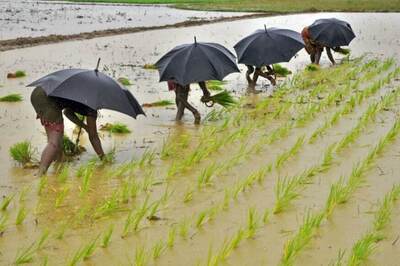
views
Southwest monsoon on Thursday made onset over Kerala, two days behind schedule, after south-westerly winds strengthening, resulting in an increase in rainfall in the state, the India Meteorological Department (IMD) DG M Mohapatra said.
The arrival of monsoon, crucial to the country’s farm-dependent economy, is announced based on factors such as wind speed, consistency of rainfall, intensity, and cloud cover.
The rainfall is expected to be well distributed, with most areas expected to receive an average to above-average amount, said Mrutyunjay Mohapatra, director general of the India Meteorological Department (IMD).
“Weather conditions have become even more favourable since we issued our last forecast in April, and that’s why we’ve upgraded our forecast,” Mohapatra told a news conference.
More than 60 per cent of the 14 rainfall monitoring stations reported rainfall 2.5 mm or more on past 2 days consecutively, the IMD said detailing the criteria fulfilled to declare the onset of the monsoon. Also the spatial distribution of rainfall over Kerala remained to be fairly widespread during past two days, it added.
The South West Monsoon is likely to advance into remaining parts of south Arabian Sea, some parts of central Arabian Sea, remaining parts of Kerala and Lakshadweep, some more parts of Tamil Nadu and Puducherry, some parts of coastal and south interior Karnataka, Rayalaseema and some more parts of south and central Bay of Bengal during next 2 days, an IMD statement said. This is the third time in the last six years that monsoon arrived late. In 2016 and 2019, Southwest Monsoon made an onset over Kerala on June 8.
The IMD had earlier forecast that monsoon would make an onset over Kerala around May 31. “Rain occurred at most places in Lakshadweep and at many places in Kerala,” a weather bulletin said.
Kayamkulam (Alappuzha district), Vythiri (Wayanad) and Chimoni (Thrissur) received 3 cm each rainfall, while Kollam, Kuppady (Wayanad) and Vilangankunnu (Thrissur) recorded 2 cm each rains, it said. Rain or thundershower is most likely to occur at most places in Kerala and Lakshadweep on Thursday and Friday, it said.
An ‘yellow alert’ indicating the possibility of isolated heavy rainfall is sounded in eight districts- Pathanamthitta, Alappuzha, Kottayam, Ernakulam, Idukki, Kozhikode, Kannur and Kasaragod, an IMD update added.
The weather office set its forecast at 101% in a range of average, or normal, rainfall that it defines as being between 96% and 104% of a 50-year average of 88 cm (35 inches) for the entire four-month season.
Its April forecast had put the figure at 98%.
Monsoon rains are expected to be average at the beginning of the season in June, Mohapatra said. It is a time when tens of thousands of farmers typically start planting crops such as rice, corn, cotton, soybeans, sugarcane and peanuts.
India’s northwest, which grows rice and cotton, could get average rainfall, while the central region, where soybean, sugar cane and cotton are grown, could receive rainfall that is above the average, the department added.
Southern India, where rice, rubber and coffee are grown, could get average rainfall, but the rains could be below average in the northeastern rice- and tea- growing region, it said.
The revised monsoon forecast would help the farm sector and minimise the risk of an escalation in food inflation at the time of an upswing in global commodity prices, said QuantEco Research economist Yuvika Singhal.
Nearly half of India’s farmland gets no irrigation and is dependent on the annual rains from June to September. Farming accounts for nearly 15% of the economy but sustains more than half of a population of 1.3 billion.
According to IMD, in 2020 and 2019, the monsoon was above normal at 110% and 109% of LPA. In 1996, 1997, and 1998, the monsoon was normal at 103.4%, 102.2%, and 104%, respectively.
(With PTI inputs)
Read all the Latest News, Breaking News and Coronavirus News here.




















Comments
0 comment